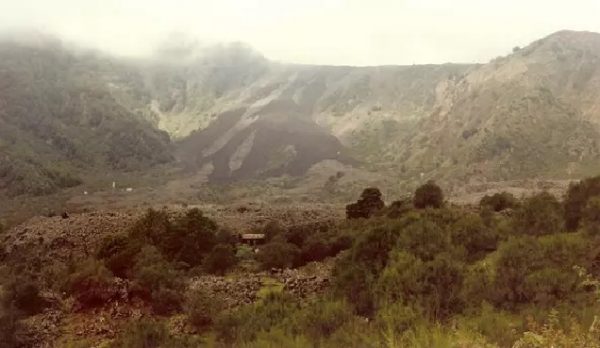To many over-50s Val Calanna is the name of their favourite camping place. This small valley that opened at the entrance of the larger valley Valle del Bove was a green group of woods. Every year, in the summer, it welcomed young explorers and campers. A loving memory that young people will never see again, since it was deleted by Mt Etna itself.
Like Valle del Bove, also Val Calanna was born millions years ago. The collapsing of the ancient volcanic system of Etna created this place. And the Salto della Giumenta hill is the testimony of the event. Today you can walk “over” Val Calanna, not inside. All the beauty of this valley is lost forever.
Val Calanna before 1991
 Before the eruption of 1991, Val Calanna was a beautiful valley, as you see in the photo on the side (by Mapio.net). It was not a desert, as the nearby Valle del Bove. Woods, water springs, cultivated fields, farms were the typical view. The springs gave water to the towns at the foot of the volcano, especially to Zafferana Etnea.
Before the eruption of 1991, Val Calanna was a beautiful valley, as you see in the photo on the side (by Mapio.net). It was not a desert, as the nearby Valle del Bove. Woods, water springs, cultivated fields, farms were the typical view. The springs gave water to the towns at the foot of the volcano, especially to Zafferana Etnea.
In the summer, campers would pitch their tents there, facing the view of the volcano’s summit craters. Farmers would give tourists their homemade products and the holidays were very natural. Elder people still remember that valley and tell about it to their children who will only see cold lava, instead, over there.
The eruption that changed everything
The longest eruption of the 20th century began on December 14, 1991. It lasted 473 days and started from a series of fractures that opened at the base of the South East Crater. The fracture went down to 2,200 meters, pouring lava into the Valle del Bove. It went at a remarkable speed, to the point of threatening the foothills.
At first, no one believed that the lava would ever reach the towns. Usually Valle del Bove contains eruptions very well. But the proximity and the slope made the rivers of fire faster . So they got to the Salto della Giumenta hill and began to fall back into Val Calanna.
Thanks to Val Calanna, though, the lava did not immediately reach Zafferana Etnea. It was held back by vegetation and allowed the Italian Army to erect a barrier which further slowed down its path. When the eruption ended in March 1993, the lava had only touched the outskirts of Zafferana. It had destroyed two houses -that had already been evacuated before- and some cultivated fields. Val Calanna, however, no longer existed. It had been totally filled.
Val Calanna today
Today Val Calanna lies under tons of solidified lava. That little paradise no longer exists. But you can still reach it starting from Zafferana Etnea and the so-called Path of Pian dell’Acqua. You can walk the track on foot or by mountain bike, for a time that reaches a total of 4 hours and 10 minutes. Just over 2 hours walk going but less for the return downhill.
The less trained or those with problems in moving can travel this route by off-road vehicle. Along the way you will see the damage that the lava has done to the houses of this area, some grazings and others completely swallowed. Then you will arrive close to the huge lava fall – now cold – that pours right on the point where it once stood Val Calanna.
On the left, or southwards, Monte Fior di Cosimo rises. To the north instead there is Monte Calanna. In front of you – under the lava – Salto della Giumenta. And beyond this hill, the magnificent view of the top of Mount Etna lets you guess all the volcano’s power. (photo above the title by Grazia Musumeci)